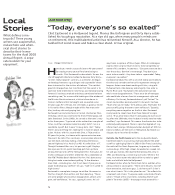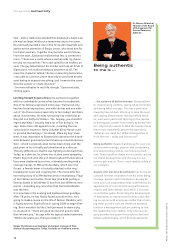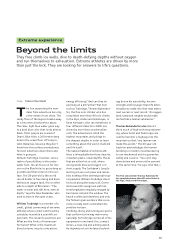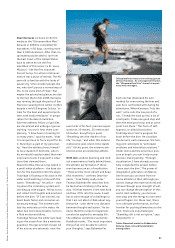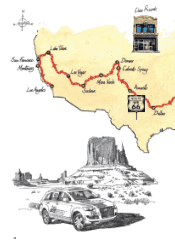Audi 2008 Annual Report Download - page 82
Download and view the complete annual report
Please find page 82 of the 2008 Audi annual report below. You can navigate through the pages in the report by either clicking on the pages listed below, or by using the keyword search tool below to find specific information within the annual report.
79
E
E
x
x
t
t
r
r
e
e
m
m
e
e
e
e
x
x
p
p
e
e
r
r
i
i
e
e
n
n
c
c
e
e
Beyond the limits
They free climb ice walls, dive to death-defying depths without oxygen
and run themselves to exhaustion. Extreme athletes are driven by more
than just the kick. They are looking for answers to life’s questions.
The free solo climber Thomas Bubendorfer
has completed more than 80 solo climbs in
the Alps, Andes and Himalayas.
he line separating the mun-
dane from adventure lies only
a few meters from shore. The
sandy floor of the lagoon breaks away
as it becomes a bottomless abyss:
The clear, light blue water gives way
to a dark blue color that looks almost
black. Most people are scared of
Dean’s Blue Hole, a 200-meter deep
hole in the ocean floor off Long Is-
land, Bahamas, because they don’t
know how this surface anomaly was
formed, what lives down there and
what is going on.
William Trubridge, however, sees a
realm of possibilities in the under-
water hole. He can focus on his mis-
sion in the Blue Hole: to go as deep as
possible and then return to the sur-
face. The 28-year-old is the world
record holder in free diving and dives
without an oxygen tank, fins or other
aids to a depth of 86 meters. “The
water is warm and still here, even at
depth,” says the New Zealander, who
used to train in the open ocean.
William Trubridge is a member of a
small, global community of extreme
athletes whose careers and training
schedules resemble a scientific ex-
periment. The research questions are:
What are the limits of human per-
formance? What is the maximum
blood volume, muscle contraction,
energy efficiency? And can they be
pushed just a bit further? But men
such as Trubridge, Thomas Bubendor-
fer, the free solo climber who has
completed more than 80 solo climbs
in the Alps, Andes and Himalayas, or
Dean Karnazes, who ran marathons in
four different deserts in 2008, are
driven by more than an adrenaline
rush. The adventurers climb the
highest mountains and plunge to
the deepest depths in order to learn
something about the world, mankind
and life itself.
The natural habitat of extreme ath-
letes is inhospitable territory: deserts,
mountain peaks, ocean depths. Places
that are either hot or cold, where
strong winds blow and oxygen is in
short supply. The Caribbean’s Long Is-
land is just one such place and resem-
bles nothing of the stereotypical tropi-
cal paradise. William Trubridge steers
his truck along the dusty trail. Green-
ish-brown hills overgrown with tat-
tered vegetation regularly ravaged by
hurricanes roll past the window. The
beach is white and deserted, and only
the flotsam gives evidence that a con-
sumer society exists somewhere be-
yond the horizon.
Climbing, diving and running are sports
that conform to the way man moves
naturally. So Trubridge carries all of his
equipment in one hand: fins, contact
lenses, a nose clip and a diving watch.
He depends not on the latest technol-
ogy but on his own ability, his own
strength and his larger-than-life deter-
mination to make it to that next meter,
next success or next record. “An oxygen
tank, lamp and weights would make
me feel like a human submarine.”
Thomas Bubendorfer also doesn’t
think much of high-tech mountaineer-
ing, where bolts and fixed ropes are
used to hammer a highway into the
mountain so that “any layman can
make the ascent.” The 46-year-old
Austrian acknowledges the human
tendency in modern mountaineering
to use mechanical aids to guarantee
safety and success. “You can’t stay
down below and arrive at the summit
at the same time,” he says. And that
Copy Tobias Moorstedt
T







